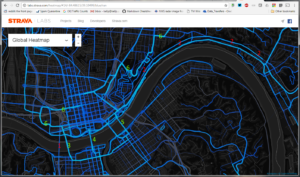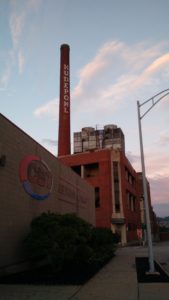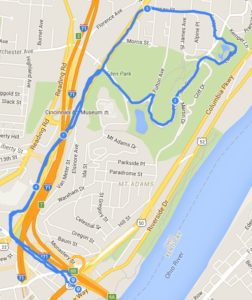In the last post, I talked about that one of the main reasons for making this blog is because I suffered a lot of downtime from an uncommon injury. The Injury. That injury was a fractured sacrum.
It happened on a 14 mile training run on April 17, 2015. Probably 4 miles in. I felt something, but didn’t know what, the pain was low (mayyyybe 1 out of 10). It grew a little, but went largely unnoticed and I was having an epic training run – my pace on the previous few runs had been over 10 min/mi, and this one was under that, despite rain. The pain grew to level 8 or so.
The back story is that I had to take a few weeks off prior to that training run due to a herniated disk in my back. I caused that one by shoveling snow too hard (because intense snow shoveling can replace a run?). My paces had been slower since then, and I had a low-level odd pain that just developed (as in I didn’t know what caused it, I just woke up and felt it) in one leg that went away after an hour or so of being awake.
Fast forward to May 1, 2016. The Little King’s Mile. I walked around the Flying Pig Expo (as I always did) in some pain. Two weeks to-the-day after this started. I knew then that things were not good. I still ran the LK Mile, though, in 7:17. PR. Three Advil removed the pain completely.
Two days following was the Flying Pig Half Marathon. I had paid for my entry several months before, and the sunk cost fallacy got me to run it anyway. In the starting corral, I took three Advil. I had three more with me for the finish line (they were never consumed) stapled in my fuel belt (to ensure I didn’t lose them when getting Gu). I ran a PR that I’m proud of – 2:01:11. Even more so, I used my “keys to the race” and general smart racing to be very happy with my splits.
I took a week to rest. Since I had little improvement, I went to see a doctor. After checking various mobility issues and an X-ray, I was sent for an MRI that located a sacral insufficiency fracture on my right side.
After two months of frequent doctor visits, I was cleared to return to cycling and walking in late June. I went to run/walk arrangements (against doctor’s orders but with the idea – not advice – from my physical therapist) on August 3. I returned back to full running on August 31 with my doctor’s OK.
The sunk cost fallacy (sort of) was getting me again. I intensively increased from damn near nothing to 9 miles by September 19 for the Hudepohl 14k. While I did not PR, I matched my time from the prior year despite significantly more heat and humidity in that year’s race. I did reduce a little in training volume after the race, but 3 weeks after that (on October 9), I was out running 8 miles and felt that pain. Diagnosis: sacral fracture on the LEFT side. And sent to see an Endocrinologist.
On December 11, I was cleared to return to light running, which I’ve maintained with a few changes in training focus and nutrition.
Training focus changes are that I am taking a significantly slower approach to mileage increase. I increase my weekly mileage every 2-3 weeks, not every week. My quality runs are intended to be true quality as opposed to quality and quantity. My easy days are becoming truly easy.
Nutrition was two things. Among the many tests the Dr. K (the endocrinologist) ordered, my vitamin D was low. After getting over-the-counter vitamin D3 pills (per Dr. K’s orders) and taking 1000 units per day, a recheck confirmed good vitamin D levels. Then he ran a dietary calcium test, which indicated low calcium. Dr. K told me to ensure I was consuming around 2,000 mg of calcium per day. I tracked my food intake for a week using MyFitnessPal, and discovered that I was around 20% of that. I went from rarely drinking milk to two glasses a day. A subsequent check of dietary calcium indicated that I was in the recommended range.





